January
2013
Strv-103B
S-Tank
SAAB
JAS39B Gripen
SAAB
JAS39C Gripen
|
January
2013 |
||
![]()
![]() Selected
WW2 70th Anniversaries this month:
Selected
WW2 70th Anniversaries this month:
Between 2009 and 2015, I have set myself a general modelling theme that marks selected 70th Anniversaries from WW2.
January 1943 - Over 300,000 troops of General Paulus' 6th Army are surrounded by two deadly enemies; the Soviet Army and the bitter Russian winter. The Lufwaffe continues its futile efforts to re-supply them by air, but over the coming month the 6th Army slowly and literally starves to death.
4 Jan - Japanese forces begin evacuating from Guadalcanal. Australian and US forces drive the Japanese invaders from Buna and Gona beacheads in New Guinea, leaving a single remaining Japanese stronghold at Sananada, which falls on 22 January.
9 Jan - Himmler orders the "removal" of 40,000 Jewish people living in the Warsaw Ghetto. 9 Days later, the Warsaw Ghetto Uprising begins. On 11 Jan, British Intelligence intercepts an encrypted report of Operation Rheinhard, revealing the successful extermination of 1.25 million Polish people up to the end of 1942 in Nazi death camps.
14 Jan - President Roosevelt and Winston Churchill meet at Casblanca and declare that the Allies will only accept the total and unconditional surrender of Germany.
22 Jan - With his final airfield overrun by the Soviets, General Paulus asks Hitler for permission to surrender. Hitler refuses. On 30 Jan, Paulus himself surrenders to the Red Army after his HQ is overrun; his forces will fight on for 2 more days before their final surrender. For the first time during the war, the Nazi regime is forced to admit to the German people that it has suffered a massive and catastrophic defeat.
23 Jan - General Montgomery accepts the surrender of Axis forces in Tripoli to the 8th Army.
27 January 1943 - The US Army Eighth Air Force launches its first bombing raid on German territory, attacking the U-Boat pens at Willemshaven. All aircraft return safely.
30
Jan - Soviet forces break the Nazi siege of Leningrad.
QinetiQ UK MoD Empire Test Pilots School, Farnborough Air Show, 2006
Italeri 1/72, with Flying Colours Aerodecals markings.
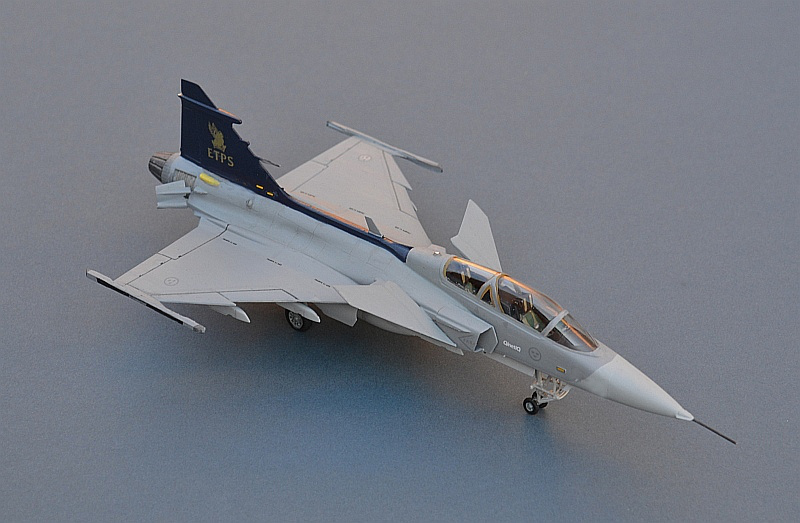
The Gripen continues a tradition of highly capable indigenous Swedish combat aircraft. It has already achieved significant export success as a replacement for aircraft of the F-16/MiG29/Mirage 2000 era and has recently (2012) gained a funding committment from the Swedish government to develop an updated New Generation (Gripen NG) version. In accordance with Swedish military doctrine, the Gripen is designed to fly from austere facilites such as roads and dispersed operating bases, with minimal and relatively low-tech support, which makes it an ideal candidate for modern expeditionary warfare. SwAF Gripens actively participated in 2012 combat operations over Libya. Twin seat Gripens are used for training; with an elongated fuselage to accomodate the second seat, they retain all of the combat capability of the single seaters bar the internal gun, but carry slightly less internal fuel.
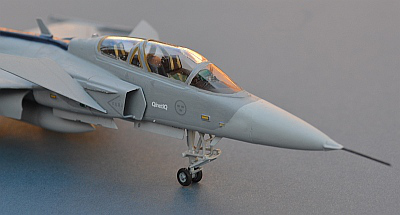
Since 1999, leased Gripens have been used by the QinetiQ-operated UK MoD Empire Test Pilot School (ETPS) to train military test pilots and Flight Test Engineers on modern high perfomance aircraft, including students from the British Royal Air Force, the Royal Australian Air Force, the United States Navy and the French Air Force. Although normally operating from SAAB's facility at Linkoping in Sweden, a specially marked ETPS Gripen is regularly seen at UK shows, and it was in this guise that it appeared at the 2006 Farnborough Air Show, complete with blue fin and spine, ETPS badge and QinetiQ titles on the forward fuselage. The blue trim and badge remain, but the QinetiQ titles apparently annoyed the Swedish Air Force and were quickly removed.
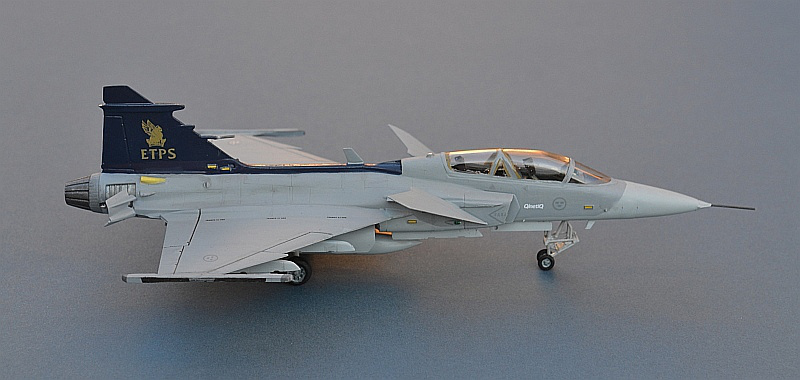
Italeri's 2-seat Gripen is currently more difficult to find than the more common single seater. It shares most sprue parts with the single seat kit, but includes a different fuselage and the weapons fit is purely air-defence orientated (AMRAAMS and Sidewinders), indeed it is identical to that supplied with the Airfix (and Tamiya?) issue of the single seater kit. The forward undercarriage doors also reflect the far more complicated set-up on the twin seater and there is a different aerial fit. As a Gripen representation, it has a few anomalies, reflecting Italeri's habit of releasing kits before the aircraft is fully developed, but is generally well engineered and crisply moulded with nicely engraved detail. There is one particularly annoying fault - an obvious mould seam inside the large clear double canopy that is very dififcult to remove (believe me, I tried and failed) but otherwise it is a good kit, albeit with some very vulnerable protrusions (the many pitot probes are unlikely to survive for long!).
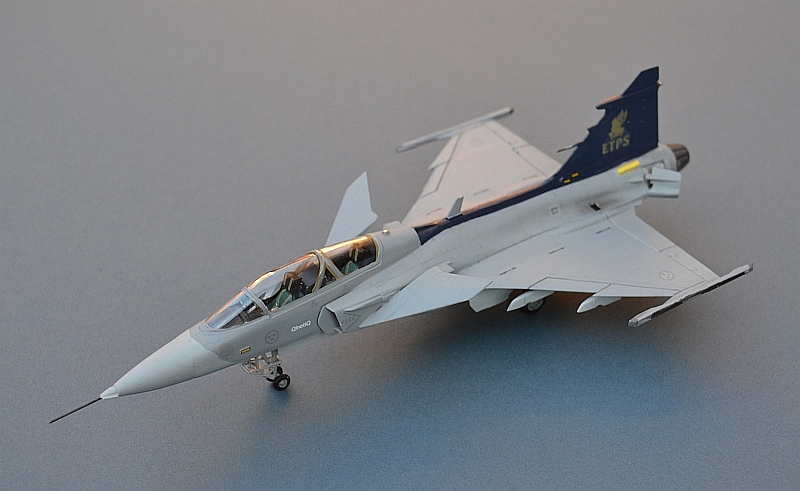
The Flying Colours Aerodecals markings came very cheaply from Hannants (SR7209) and consisted of the gold ETPS badges and white QuinetiQ titles; the rest of the markings are from the kit. Paint is Humbrol enamel (mainly 126, 127 and 104 for the spine), with a Klear sealing coat, light oily wash and finished off with a Windsor & Newton matt varnish top-coat.
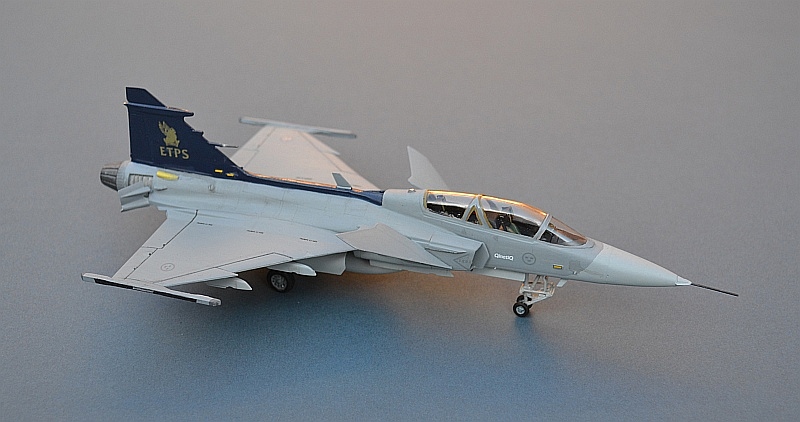
SAAB
JAS39C Gripen
F7
Wing, Flygvapnet (Swedish Air Force)
Satenas
Air Base, Skaraborgs Province, Sweden, 2012
Italeri 1/72, with Revell-sourced additional weapons.
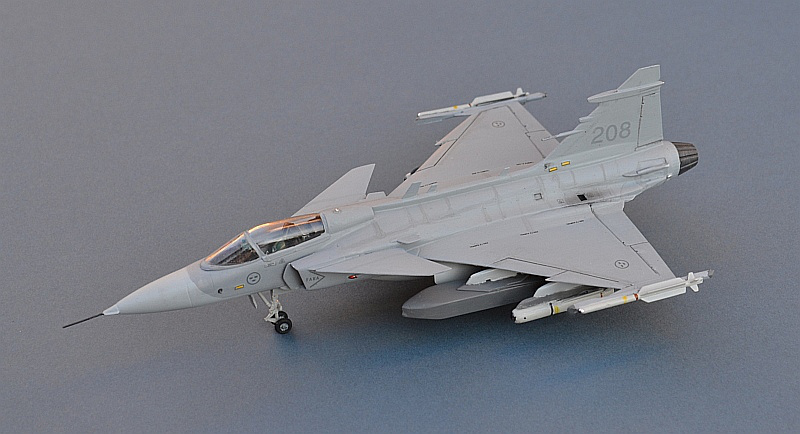
|
Swedish Air Force |
Compared with the JAS39A, the C variant of the Gripen adds a more powerful engine, air to air refuelling capability and improved NATO weapons compatability via a Mil-Std databus. With a new colour glass cockpit, the JAS39C retains all the air to air capability of the JAS39A, but provides additional air to ground capabilities and new weapons systems including the KEPD350 Taurus cruise missile. Similar to the UK-French Storm Shadow / Apache missile, Taurus is larger and with a greater (<500km) range, onboard defensive counter measures and specialist anti-bunker warhead. As well as new build aircraft, many existing JAS39A aircraft have now been converted to C standard. Gripens now also carry the latest IRIS-T short range air-to-air missile, a highly agile and full backward compatible Sidewinder replacement. |
The standard Italeri single-seat Gripen is intended to represent the JAS39A model, but as the two variants are effectively identical from the outside I have marked this one up as a C model, adding some spare Taurus and IRIS-T missiles from the Revell Typhoon kit.
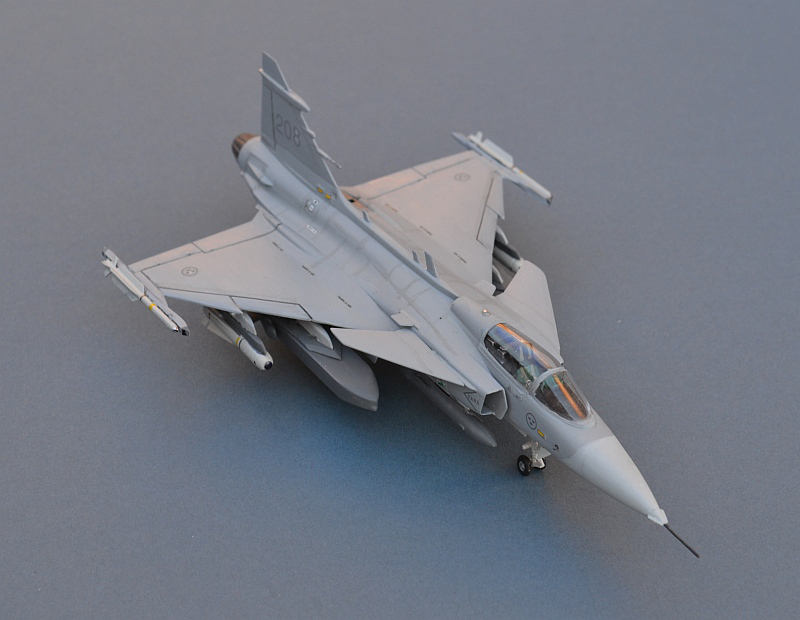
As supplied, the kit comes with a nice set of 2xSidewinders, 2xRBS-15 anti-ship missiles and 2xMavericks (the last of which I have used); whether such a bizarrely mixed short-long range weapons load is feasible (or even useful), I don't know, but certainly gives my Gripen a suitably "loaded" look!
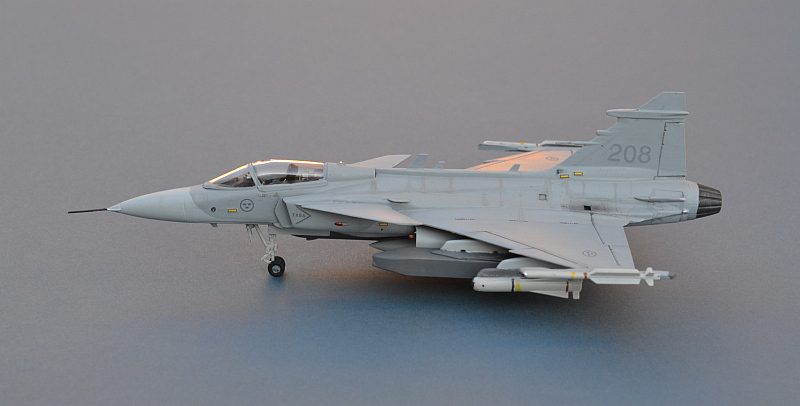
Decals come mainly from the box, with a few additions to reflect the C model. Paint is as above (minus the blue of course) with some additional greys for the weapons.
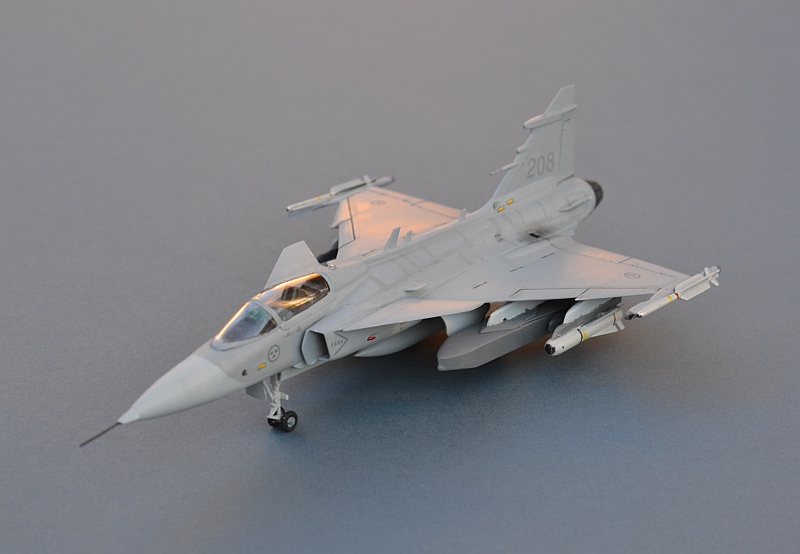
Purely for completeness, here is my model of a JAS39A, built about 6 years ago (the Airfix issue of the same kit):
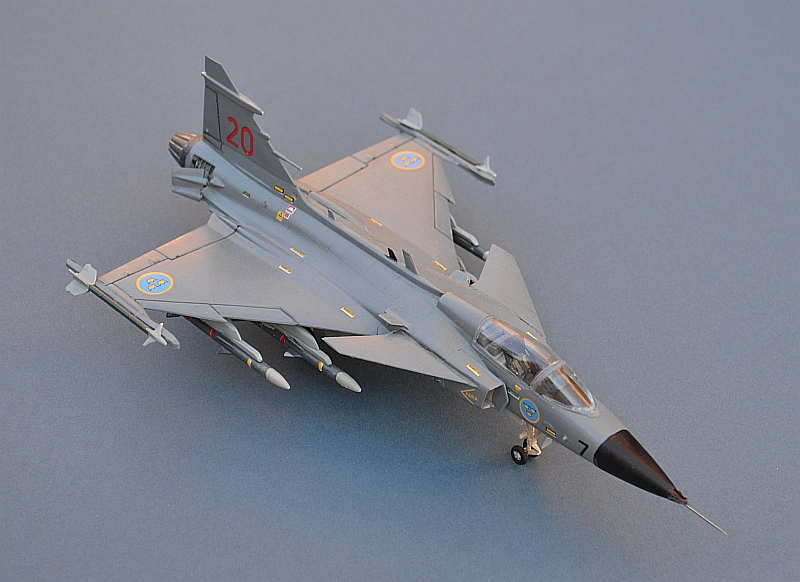

And finally, here are all 3 of my "Gripen fleet" together; as you can see, the A-model has already had his pitot replaced, after a minor storage/transport accident !!!!

More Swedish aircraft on my Friends & Allies pages
Skaraborgs Regemente, Svenska arméns paradmarsch (Swedish Army)
Trumpeter 1/72, built out the box.
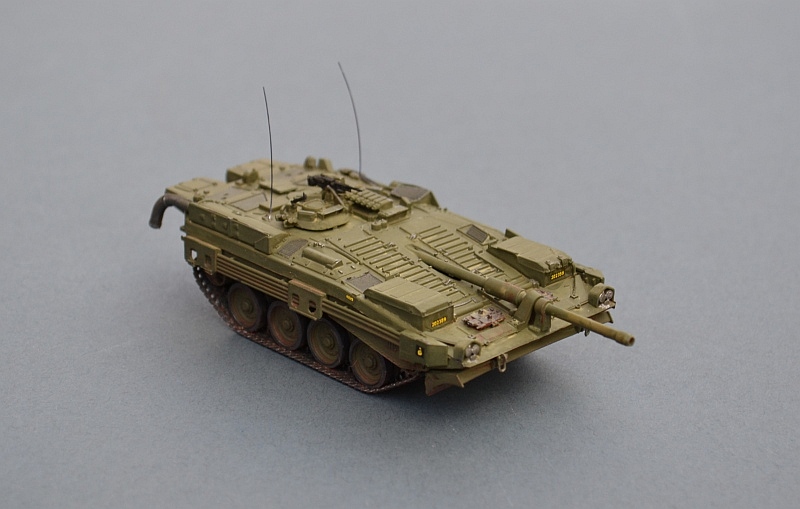
|
Swedish Army Crest |
The Stridsvagn (Battle Chariot) 103 was a truly radical AFV design, introduced by the Swedish Army in the mid 1960s to replace their Centurion MBTs. Optimised for defensive combat operations, the tank had an exceptionally low profile and compact overall dimensions, due to its lack of a main gun turret. A sensitive hydraulic suspension and steering system allowed the fixed hull-mounted 105mm gun to be aimed by traversing, raising or lowering the entire tank hull. Powered by a Rolls Royce K60 diesel for normal travel, with an auxiliary Boeing gas turbine providing extra dash power when needed, its ammunition auto-loader allowed a crew of only two, with a third rearward facing driver permitting the tank to proceed at equal speed in either direction. A large integral flotation screen allowed it to cross rivers and lakes, whilst toughened steel bar armour on the sides and front was fitted to defeat contemporary armour defeating ammunition. S-tanks saw several updates and remained in front-line service until the late 1990s, when they were finally replaced by the Strv-122 Leopard 2. |
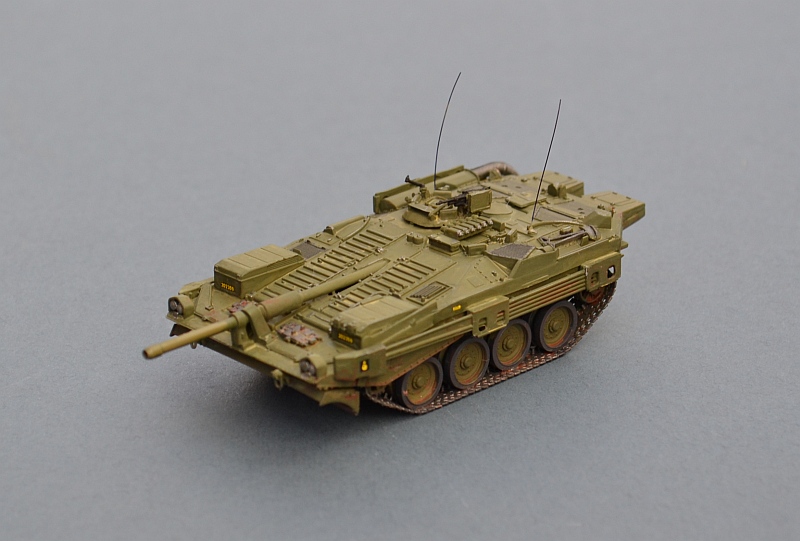
This kit was acquired at this year's Scale Model World show at Telford, where several vendors were selling off older Trumpeter kits at significantly reduced prices. This one features excellent detail and is a very easy build of an unusual subject (I dont think anyone else does on in 1/72 or indeed 1/76), although as always a little more information on the units featured in the decals would be appreciated. Tracks were a single length of soft vinyl (admirably thin too), but despite Trumpeter's claims that they can be glued with polystyrene cement mine steadfastly refused to stick together, so a few hidden staples sufficed instead!
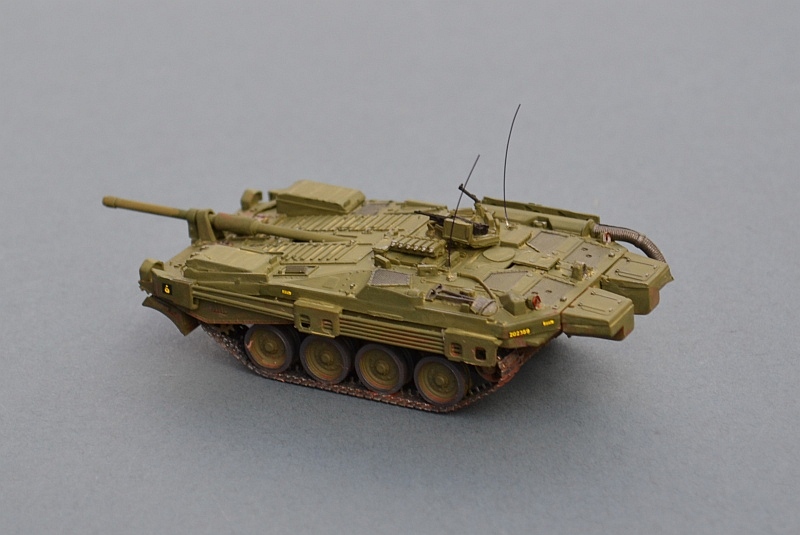
Trumpeter also make the later Strv 103C variant, with slightly different suspension, turret and additional side armour. Some, but not all of the needed parts were on the sprues of this kit, so I assume the later version comes with an additional sprue.
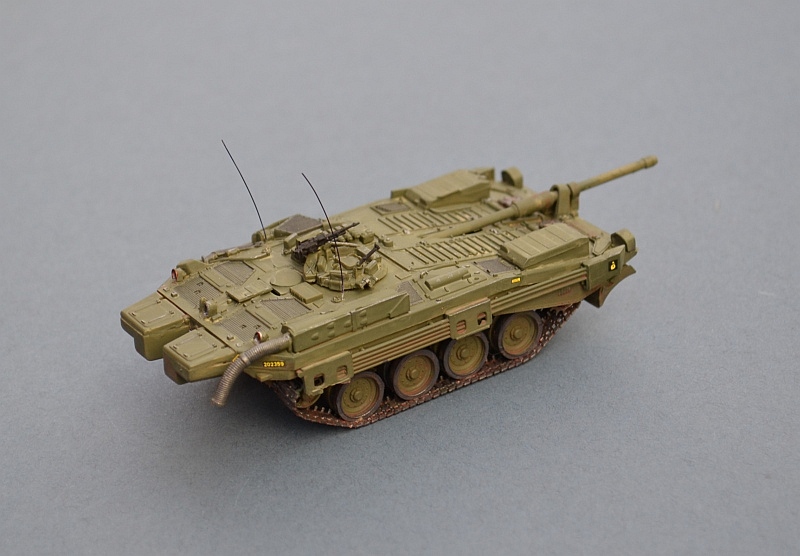
Paint is Revell enamel, with an overall light wash of Citadel desert yellow and some burnt sienna mud for the under sides. Radio antennae are bits of monofilament line - they do straighten up in time, honest!!!
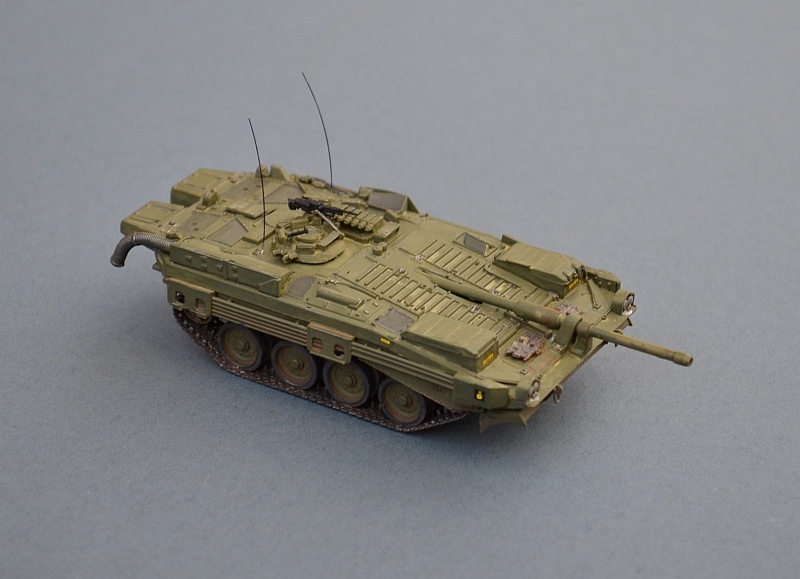
More vehicles my Dark Side AFV pages
Link to previous month Link to Next Month
www.gengriz.co.uk
Background Image - Supermarine Spitfire